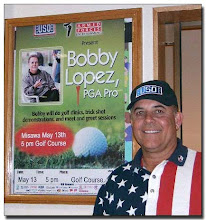How To Read Golf Greens for Speed and Break
Short putts and long putts, are played with the same golf club even though the stroke pattern and purpose are quite different. Short putts demand club face control while the long putts demand pace control. The short putting stroke should be as short as possible to lower the risk of changing your club face position after aligning the club face at the target. The long putt stroke can be long and flowing because controlling the pace of the ball speed is your goal.
You’ll find when you three putt a green most of the time you left your putt short or you knocked it past the hole, unless there was a significant amount of break that you did not negotiate properly. It is usually the pace or speed of the ball that is the most difficult to control, especially on super fast greens like Augusta.
Today we discuss long putts and how to first determine the speed then the break. Most golfers look at the break first. I first have to make a decision on how fast I’m willing to roll the ball before I decide how much break or curvature the ball will take over the surface it has to cover. The slower I roll the ball the more it will break or curve.
I look at the green from 150 yards first to see any tendencies of lean one way or the other. If I threw a bucket of water on that green which way would it flow off?
Once reaching the green you need to look at the putt from both sides to gather all the information you can about the surface you are about to roll the ball on. I suggest that you drive your golf cart to the back of the green each time, (being that most golfers leave their ball short of the hole on approach) and then walk around the back of the putt first. Try walking a half moon circle around the putt rather than straight to the ball. Look at how the green leans. Understand that the designer of the green had to account for water to flow off the green for drainage purposes. Find the area of drainage and you’ll have the keys to the “lean” of the green.
Look at the coloration of the green. Is the color a deep dark green and thick or is it light brown with very thin grass blades? Is it up hill or down? Is there a ridge where the ball will speed up on you and run by the hole? Make a determination while walking around the hole as to how fast you need to roll the ball. Then once behind the putt, meld the information you acquired from looking at the putt from the back and the frontal view you have. Now and make an educated guess at the amount of break you should play for.
Remember if you are off on your amount of break by a foot or two it probably won’t cause you to three putt. It’s that putt you leave seven feet short or twelve feet past the hole that will cause you to three putt. Get the pace first, then the line.


0 Comments:
Post a Comment
<< Home